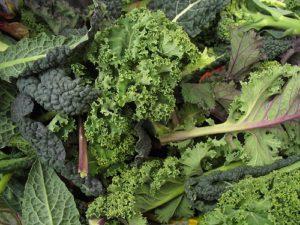Before the holidays, we told you about the role vitamin D plays in maintaining a healthy smile. Like magnesium, it helps your body better absorb and assimilate calcium. In fact, according to a 2011 study published in Nutrients, when it comes to improving bone health, this nutritional combo – D and calcium – proves better than any drug for rebuilding bone.
 But there’s another important nutrient in this dynamic: vitamin K.
But there’s another important nutrient in this dynamic: vitamin K.
Like D, K occurs in a couple forms: K1 and K2. Most of what we get from diet is K1, which is made by plants. K2 is largely produced by gut flora (intestinal bacteria). Both forms are fat-soluble, meaning they can be stored in the body to be used as needed. K helps with blood clotting and preventing calcification of the blood vessels and heart valves. It also, writes Dr. Theodore Herrmann on his blog, “protects against oxidative damage, properly regulates inflammatory responses and supports the brain and nervous system structure.”
And when it comes to calcium absorption, K appears to work in tandem with D to get the job done. As Dr. Mercola writes,
One of the undisputed benefits vitamin D provides for you is improved bone development by helping you ABSORB calcium. This is not new….
But there is new evidence that it is the vitamin K (specifically, vitamin K2) that directs the calcium to your skeleton, while preventing it from being deposited where you don’t want it – i.e., your organs, joint spaces, and arteries. A large part of arterial plaque consists of calcium deposits (atherosclerosis), hence the term “hardening of the arteries.”
Vitamin K2 activates a protein hormone called osteocalcin, produced by osteoblasts, which is needed to bind calcium into the matrix of your bone. Osteocalcin also appears to help prevent calcium from depositing into your arteries.
You can think of vitamin D as the gatekeeper, controlling who gets in, and vitamin K as the traffic cop, directing the traffic to where it needs to go.
Lots of traffic – but no traffic cop – means clogging, crowding and chaos everywhere!
In other words, without the help of vitamin K2, the calcium that your vitamin D so effectively lets in might be working AGAINST you – by building up your coronary arteries rather than your bones.
There is even evidence that the safety of vitamin D is dependent on vitamin K, and that vitamin D toxicity (although very rare with the D3 form) is actually caused by vitamin K2 deficiency. [emphasis in the original]
 To make the most of the vitamin D – and thus calcium – you get, then, look to increase your intake of K. Good sources include
To make the most of the vitamin D – and thus calcium – you get, then, look to increase your intake of K. Good sources include
- Dark, leafy greens
- Broccoli and other cruciferous vegetables
- Avocado
- Kiwi
- Grapes
- Meat
- Eggs
Because K is fat-soluble, including some healthy fats when you eat such foods – cooking them with a bit of olive oil, say, or drizzling flaxseed oil on top – will help your body assimilate the vitamin even better.
And how much K do you need? The minimum recommendations are 90 mcg daily for women and 120 for men, which is easily met or exceeded by a single serving of vegetables such as lettuce, asparagus or broccoli. You’ll find a good list of high vitamin K foods here.
Greens image by Tapir Girl, via Flickr